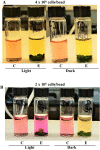Engaging inexpensive hands-on activities using Chlamydomonas reinhardtii (a green micro-alga) beads to teach the interplay of photosynthesis and cellular respiration to K4-K16 Biology students
- PMID: 32904417
- PMCID: PMC7453928
- DOI: 10.7717/peerj.9817
Engaging inexpensive hands-on activities using Chlamydomonas reinhardtii (a green micro-alga) beads to teach the interplay of photosynthesis and cellular respiration to K4-K16 Biology students
Abstract
Background: Photosynthesis and cellular respiration play major roles in energy metabolism and are important Life Science topics for K16 Biology students. Algae beads are used for photosynthesis and cellular respiration labs. Currently there are a few companies that sell biology educational kits for making algae beads using non-motile green micro-algae to introduce students to photosynthesis. These kits are expensive and, do not come with detailed guidelines for trouble shooting and customizations for different grade levels. Chlamydomonas reinhardtii is a motile green micro-alga and is an excellent model system for photosynthesis studies. In this article, we are presenting the work conducted in the student-driven, American Society of Plant Biologists-funded, Plant-BLOOME educational outreach project. This project is a supervised collaborative effort of three undergraduates and one high school student. We have generated a protocol which can be used to make Chlamydomonas beads. We have used these beads to design two simple and inexpensive plant biology hands-on activities. These laboratory activities have been customized to teach the interplay of photosynthesis and cellular respiration to K4-K16 Biology students.
Methods: Chlamydomonas beads were used for two different laboratory activities that involved monitoring pH changes over time using a pH indicator. Our first activity centers on making and, using light-powered algae bead bracelets to monitor dramatic color/pH changes over time when exposed to darkness or light. Our second activity employs strain-specific algae beads with approximately equal cell numbers to conduct comparative photosynthesis and cellular respiration studies in two Chlamydomonas strains namely, wild type, 4A+ and, a high light-sensitive, photosynthetic mutant, 10E35/lsr1a.
Results: We optimized our experimental protocol using algae beads in a 5.5 mL screw capped glass vials before performing the same experiment in algae bead bracelets. We found that the algal cell density/bead, water type used in the experiment and, the duration of dark exposure of algal beads can affect successful implementation of the lab activities. Light-powered algae bead bracelets showed dramatic color/pH changes within 3 h upon exposure to light or darkness. These bracelets could be switched back and forth between darkness and light multiple times within 48-72 h to display color/pH changes, provided prior dark exposure time did not exceed 9 h. Our comparative studies of photosynthesis and cellular respiration in 10E35 and in 4A+ showed that relative respiration rate and photosynthetic rate is higher and lower in 10E35, respectively, compared to that in 4A+. Additionally, 10E35 failed to display the expected photosynthesis-induced pH/color changes in the light after prolonged exposure to darkness which indicated that prolonged dark exposure of 10E35, hindered photosynthesis.
Keywords: Algae bead bracelets; Algal beads; Biology education; Cellualr respiration; Chlamydomonas; Green micro-alga; Light-powered algae bracelets; Photosynthesis; Plant biology.
©2020 Mitra et al.
Conflict of interest statement
The authors declare there are no competing interests.
Figures









Similar articles
-
Identification of distinct pH- and zeaxanthin-dependent quenching in LHCSR3 from Chlamydomonas reinhardtii.Elife. 2021 Jan 15;10:e60383. doi: 10.7554/eLife.60383. Elife. 2021. PMID: 33448262 Free PMC article.
-
Day/Night Separation of Oxygenic Energy Metabolism and Nuclear DNA Replication in the Unicellular Red Alga Cyanidioschyzon merolae.mBio. 2019 Jul 2;10(4):e00833-19. doi: 10.1128/mBio.00833-19. mBio. 2019. PMID: 31266864 Free PMC article.
-
Strategies to Study Dark Growth Deficient or Slower Mutants in Chlamydomonas reinhardtii.Methods Mol Biol. 2021;2297:125-140. doi: 10.1007/978-1-0716-1370-2_13. Methods Mol Biol. 2021. PMID: 33656676
-
Photosynthetic H2 metabolism in Chlamydomonas reinhardtii (unicellular green algae).Planta. 2007 Oct;226(5):1075-86. doi: 10.1007/s00425-007-0609-9. Epub 2007 Aug 25. Planta. 2007. PMID: 17721788 Review.
-
Light stress and photoprotection in Chlamydomonas reinhardtii.Plant J. 2015 May;82(3):449-465. doi: 10.1111/tpj.12825. Epub 2015 Apr 9. Plant J. 2015. PMID: 25758978 Review.
Cited by
-
Inexpensive DIY Bioprinting in a Secondary School Setting.J Microbiol Biol Educ. 2023 Apr 10;24(2):e00124-22. doi: 10.1128/jmbe.00124-22. eCollection 2023 Aug. J Microbiol Biol Educ. 2023. PMID: 37614896 Free PMC article.
References
-
- Algae Immobilised in Alginate balls Studies of photosynthesis and respiration — Gene Technology Access Centre. 2016. https://www.gtac.edu.au/wp-content/uploads/2016/01/Algae_AlginateBalls_L.... [19 May 2020]. https://www.gtac.edu.au/wp-content/uploads/2016/01/Algae_AlginateBalls_L...
-
- American Society of Plant Biologists . 2020. [19 May 2020]. The 12 Principles of Plant Biology.
-
- Bio-Rad . 2020. [1 July 2020]. Photosynthesis and Cellular Respiration Kit for General Biology Instructor’s Guide.
-
- Carolina Quicktips Making Algae Beads — Carolina Biological https://www.carolina.com/pdf/activities-articles/carolina-qt-making-alga.... [3, July 2020]. https://www.carolina.com/pdf/activities-articles/carolina-qt-making-alga...
Associated data
LinkOut - more resources
Full Text Sources
Research Materials
Miscellaneous

